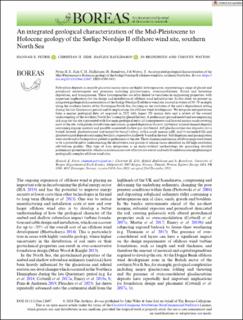| dc.description.abstract | Subsurface deposits in recently glaciated marine areas are highly heterogeneous, representing a range of glacial and postglacial environments and processes including glacitectonism, overconsolidation, fluvial and lacustrine deposition, and transgression. These heterogeneities are often linked to variations in engineering properties, with important implications for the design and installation of offshore wind infrastructure. In this study we present an integrated geological characterization of the Sørlige Nordsjø II offshore wind site, located in waters of 50–70 m depth along the southern border of the Norwegian North Sea, focusing on the evolution of the area's depositional setting during the late Quaternary period and its implications for offshore wind development. We integrate interpretations from a marine geological data set acquired in 2022 with legacy 3D seismic data and a review of the current understanding of the southern North Sea's complex glacial history. A preliminary ground model and accompanying risk map for the site is presented with five main geological units: (i) homogeneous and layered marine sands covering most of the site, with patchy distribution and coarser-grained deposits in the east; (ii) buried, layered channel deposits containing organic material and possible associated shallow gas; (iii) buried, stiff glacilacustrine clay deposits; (iv) a buried, layered, glacitectonized unit incised by tunnel valleys, with a sandy marine infill; and (v) mounded tills and glacitectonized deposits containing boulders, exposed to shallowly buried in the east. Salt diapirism and gas migration were also found to be important potential geohazards at the site. Three-dimensional seismic attribute maps were found to be a powerful aid to understanding the distribution and genesis of seismic facies identified on 2D high-resolution sub-bottom profiles. This type of data integration is an under-utilized methodology for generating detailed preliminary ground models, which can inform more cost-effective site survey and early foundation concept planning at geologically complex offshore wind sites. | en_US |

